Mountain high: 8 days through New Zealand’s glacier country


Stop at Roys Peak near Wānaka on this 8-day glacier-hop across New Zealand’s South Island/Te Waipounamu. (Image: Paige Richardson)
This 8-day glacier-hop across New Zealand’s South Island/Te Waipounamu is where winter and hiking dreams peak, promising the ultimate mountain high.
Each kick of a cramponed boot sends a small shower of tiny crystals into the air, which then thaw and join the pale blue rivulets of meltwater running between my feet. Ahead, 40-metre-high seracs (pinnacles of ice) perilously lean over the terminal face of the glacier, and deep crevasse wounds sprawl out in every direction. In the centre of the gnarly scene, a giant mass of bedrock juts out, splitting the ragged ice river in two and opening a gap in the horizon.
I’m one of five tiny humans traversing the tippy-top of New Zealand’s steepest and fastest-moving glacier. In front of me, Jon – my friendly mountain guide – is hacking his way up the ice, pointing out nature’s own caves, arches, tunnels and towers.
Franz Josef is one of around 3000 glaciers in New Zealand, most of which are scattered over the Southern Alps in Aotearoa’s South Island/Te Waipounamu. Along with neighbouring Tasman and Fox glaciers, Franz Josef makes up one of the ‘big three’ to see on a trip to the southern isle. And their relative proximity – within 20 kilometres of each other – means you can take in all three (and much more!) in an eight-day loop. Here’s the route I followed.

Franz Josef Glacier. (Image: Paige Richardson)
Day one: Christchurch/Ōtautahi to Greymouth
You can travel by car from east to west in under three hours, but you might regret not taking the TranzAlpine scenic train. The roughly four-hour trip is considered one of the world’s best locomotive journeys, navigating tunnels and viaducts, including the 8.5-kilometre-long Otira tunnel which burrows through the bedrock of the Southern Alps. From here, it’s all downhill: through the Taramakau River Valley, alongside Lake Brunner and into Greymouth.
Must-do
Carve your own greenstone
Pick up a pounamu (greenstone) pendant or sculpture before hitting the road to Hokitika. Visit Shades of Jade, which carves with flower jade, a rich green pounamu with gold or white markings that is sourced directly from Greymouth, or pop in to see Garth at Garth Wilson Jade, whose ancestors were the original traders of pounamu on the West Coast.
Stay
Firefighting memorabilia lines the walls of the heritage-listed Hokitika Fire Station, which has been lovingly restored into five spacious apartments in the heart of ‘Hoki’, in close proximity to tomorrow’s adventures.

State Highway 8 Canterbury. (Image: Paige Richardson)
Day two: Hokitika
Don’t be fooled by this coastal idyll; there is much more to Hokitika than meets the eye. After exploring its gorges and glow worms, travel 1.5 hours south to Okarito and onto Franz Josef.
Must-see
Hokitika Gorge
It’s worth the 32-kilometre detour to see Hokitika Gorge’s glacial-fed ravine, sculpted by half a million years of glacial movements. Take the trail down to the original swing bridge and follow the boardwalk to the new, extended one-hour loop track.
Okarito Lagoon
Swade and Paula run guided eco-tours and private charters of New Zealand’s largest unmodified estuarine lagoon. You’ll get your first glimpse of Tasman and Franz Josef glaciers from the lagoon, and the opportunity to spot endangered birdlife including the sacred kotuku (white heron).
Stay
Wake up to spectacular views of Franz Josef Valley and Fritz Glacier at Alpine Escape, just north of Franz Josef village.

Okarito Boat Tour views. (Image: Okarito Boat Tours)
Day three: Franz Josef
Known by its Māori name, Kā Roimata o Hine Hukatere (‘The tears of Hine Hukatere’), this glacier is relatively easy to see, as it’s just five kilometres from town. But to put crampon to ice you’ll need some wings. Franz Josef Glacier Guides run heli-hike tours of the glacier, where you can expect to find some of the country’s most mind-boggling icy terrain.
Since COVID-19, Glacier Guides have moved their guiding operation above the main ice fall, where the glacier moves up to five metres each day. This, combined with the gradient of the glacier, results in deeper crevassing and even taller seracs.
Must-do
Franz Josef Glacier Hot Pools
Warm-up in the Glacier Hot Pools nestled in the native rainforest on the outskirts of Franz Josef village. Book ahead to avoid missing out.

Hike through the Franz Josef Glacier. (Image: Paige Richardson)
Day four: Fox Glacier
Franz Josef’s twin, Fox Glacier, is just 26 minutes down the road, and worth a visit on your way to Wanaka. Take a short flight with The Helicopter Line to land on the snow plains atop the glacier, or set off on a guided hike along the valley floor with Fox Glacier Guiding.
Must-see
The Blue Pools
Allow plenty of time to travel over Haast Pass, stopping outside Makarora to tramp through beech and podocarp forest to the stunningly clear Blue Pools. The aquamarine waters are fed by the Makarora River, which flows from nearby mountains in Mt Aspiring National Park. Take a dip if you dare.

Take a Fox Glacier Guiding tour. (Image: Fox Glacier Guiding)
Day five: Queenstown
With five fields (Cardona, Treble Cone, The Remarkables, Coronet Peak and the exclusive Soho Basin) and one of the longest ski seasons in the Southern Hemisphere, Queenstown is a true skiing mecca. Hit the slopes or try heli-skiing, or schedule any number of bungy and jet-boating adventures.
Stay
Kamana Lakehouse is the highest-altitude accommodation in Queenstown, promising sweeping views of Lake Wakatipu and The Remarkables, as well as stylish rooms and private hot tubs.

Take the leap at Queenstown’s AJ Hackett Bungy Karawau Bridge. (Image: Paige Richardson)
Day six: Queenstown to Twizel
Head north on State Highway 6 through the Gibbston Valley, over the dramatic Lindis Pass and on to Omarama. From here, the easy drive to Twizel takes you through picturesque sheep farming country fringed with epic mountain ranges.
Stay
Set high among the tussocks of the Newlands’ family sheep farm, SkyScape is more than just a spot to rest your head. Designed with all-glass ceilings and boasting a two-metre-long outdoor bath, it’s the ultimate stargazing experience.

Stay at the stunning SkySkape. (Image: SkySkape)
Day seven: Tasman Glacier
The hour-long drive from Twizel to Aoraki/Mt Cook National Park, along the shores of Lake Pukaki and against a backdrop of Aoraki/Mt Cook (or ‘cloud piercer’ in Māori), could be New Zealand’s prettiest. In the park’s heartland, you’ll find the last of the country’s geographic signatures: the mighty Tasman Glacier. This 27-kilometre-long icy river is fed by numerous tributaries and is known for its epic frozen caves.
Must-see
Hooker Valley Track
Suitable for big and little trampers, the Hooker Valley Track leads you along frosty boardwalks and over swing bridges to a soundtrack of calving glaciers and avalanches at Mt Sefton. The hike theatrically ends at the iceberg-dotted Hooker Lake.

Looking towards Mt Cook. (Image: Paige Richardson)
Day eight: Christchurch/Ōtautahi via Lake Tekapo
Canterbury’s golden tussock-covered plains are the main attraction on today’s route back to Christchurch. Allow plenty of time for stops at some of the surreal blue hydro lakes that ring the region.
Must-see
Lake Tekapo
At the foot of Mt John lies Lake Tekapo, an idyllic aquamarine lake that’s so striking you’ll need to unhinge your jaw on arrival. Don’t worry; you won’t soon forget it. Like most scenes in New Zealand, you’ll leave this one thinking it performed a little magic on you.

The vivid colours of Lake Tekapo. (Image: Paige Richardson)
Want more of New Zealand? Read All 101 Reasons To Stop Dreaming About New Zealand And Go Here.


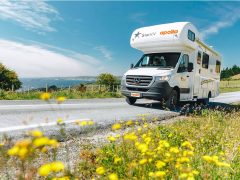
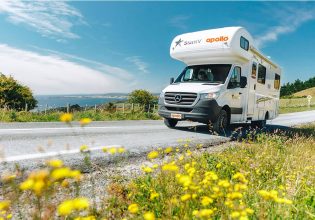


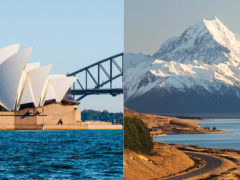
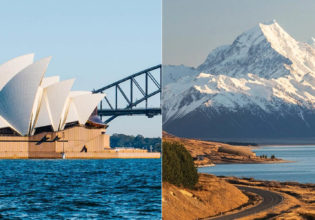
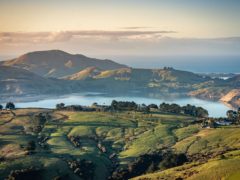
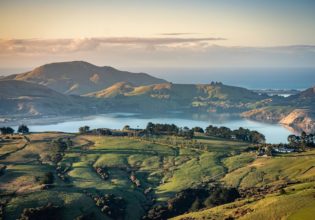
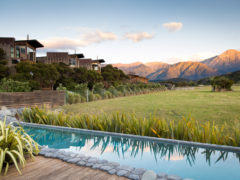
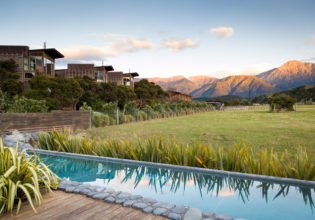

LEAVE YOUR COMMENT